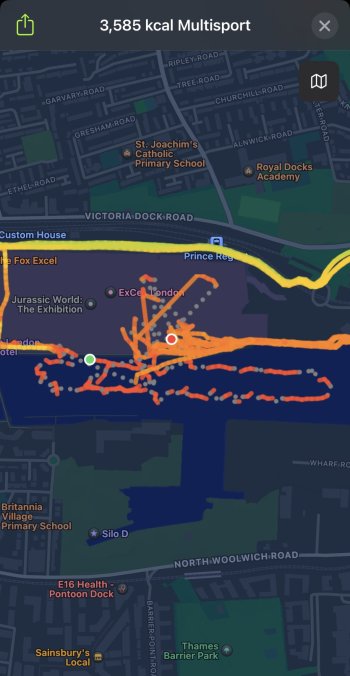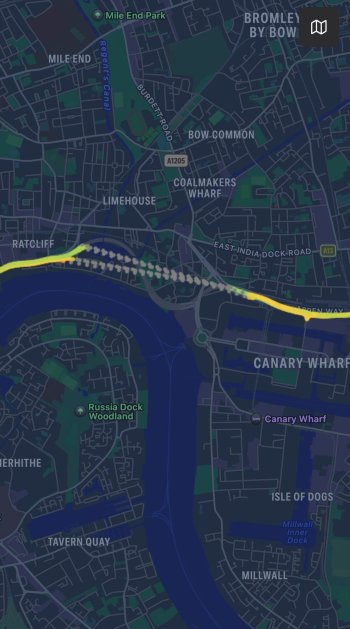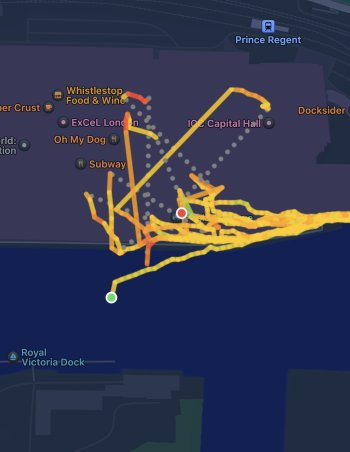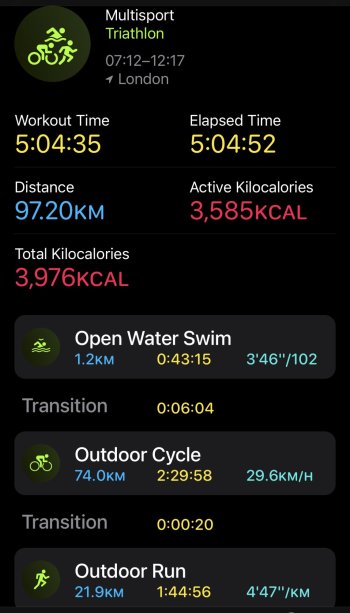On Sunday I did a middle distance (AKA Half Ironman distance) triathlon and used my Ultra to track it. Its viability for endurance workouts has been extensively discussed, so I figured to actually use it and see how it works. It's a course with a 1900m open water swim, 80km bike ride, and 21.1km run that took 5 hours to complete in total. The course was also very challenging for GPS tracking with a lot of tunnels and metal obstructions.
Battery Life
One of the biggest downsides of an Apple Watch as a fitness tracker is its low battery life. I'd say that the battery life was good enough. My watch has 100% battery health but I kept the watch on low power mode (without turning on the reduced GPS and heart rate readings) and the 5-hour workout consumed 30% of its battery. So I wouldn't use an Apple Watch for a workout that goes beyond 15 hours.
GPS Accuracy
The distance and location tracking was the biggest weak point. Firstly, the open water swim was very janky (see below).

This caused the swim to be undercounted by approximately 600 m. The bike section was also undercounted by 8 km because there were plenty of tunnels on the bike course (see below).

The run course was complex with some portions being indoors and the remainder being in the East London Docklands area with buildings, cranes, and other metal obstructions. The run tracking was actually pretty accurate in the outdoors section, but the GPS was janky when entering the indoors section (see below).

The measured course was 21.1 km, but the watch recorded 21.95 km which was a little bit over.
While the GPS was problematic, it was a challenging course for GPS tracking and I had similar issues with my Garmin watch in a similar race last year. So it fell in line with what I expected.
Other Factors
I used the ocean band with the watch and have no complaints. It stayed on the whole time and remained comfortable. While the action button was helpful, I mistakenly pressed it too early in the second transition so my run time is overcounted by 5 minutes. Also on the bike, I turned on both my watch and a dedicated bike computer simultaneously (bike computers are both safer and more convenient than wrist-worn activity trackers), and it unsurprisingly also had the same GPS issues in the tunnels. If you want to get a more detailed analysis for things like splits, training stress score, training load, etc you need to download an app like Healthfit. However, after my race, it was nice to turn off low power mode and use it like a normal Apple Watch immediately after.
So there you go. Its battery life is good enough if your workout is less than 15 hours, and its GPS is accurate on the bike and run as long as you're outdoors. The swim tracking was disappointing though, but it tracked the distances of my training swims with much better accuracy so it may just be the location. I think I'll use it again in my future races.

Battery Life
One of the biggest downsides of an Apple Watch as a fitness tracker is its low battery life. I'd say that the battery life was good enough. My watch has 100% battery health but I kept the watch on low power mode (without turning on the reduced GPS and heart rate readings) and the 5-hour workout consumed 30% of its battery. So I wouldn't use an Apple Watch for a workout that goes beyond 15 hours.
GPS Accuracy
The distance and location tracking was the biggest weak point. Firstly, the open water swim was very janky (see below).

This caused the swim to be undercounted by approximately 600 m. The bike section was also undercounted by 8 km because there were plenty of tunnels on the bike course (see below).

The run course was complex with some portions being indoors and the remainder being in the East London Docklands area with buildings, cranes, and other metal obstructions. The run tracking was actually pretty accurate in the outdoors section, but the GPS was janky when entering the indoors section (see below).

The measured course was 21.1 km, but the watch recorded 21.95 km which was a little bit over.
While the GPS was problematic, it was a challenging course for GPS tracking and I had similar issues with my Garmin watch in a similar race last year. So it fell in line with what I expected.
Other Factors
I used the ocean band with the watch and have no complaints. It stayed on the whole time and remained comfortable. While the action button was helpful, I mistakenly pressed it too early in the second transition so my run time is overcounted by 5 minutes. Also on the bike, I turned on both my watch and a dedicated bike computer simultaneously (bike computers are both safer and more convenient than wrist-worn activity trackers), and it unsurprisingly also had the same GPS issues in the tunnels. If you want to get a more detailed analysis for things like splits, training stress score, training load, etc you need to download an app like Healthfit. However, after my race, it was nice to turn off low power mode and use it like a normal Apple Watch immediately after.
So there you go. Its battery life is good enough if your workout is less than 15 hours, and its GPS is accurate on the bike and run as long as you're outdoors. The swim tracking was disappointing though, but it tracked the distances of my training swims with much better accuracy so it may just be the location. I think I'll use it again in my future races.


